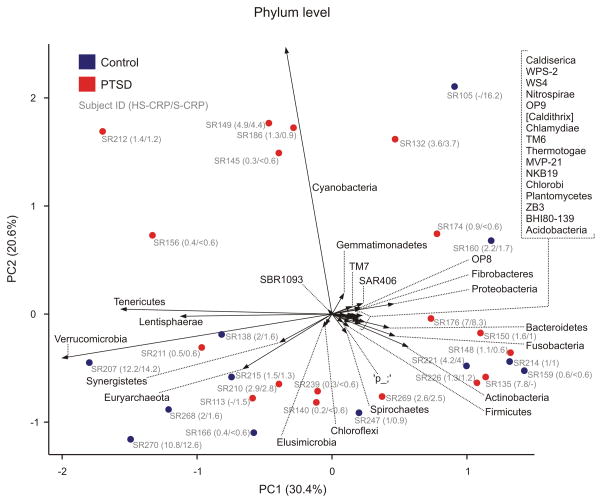Figure 2.
Biplot illustrating phylum-level gut microbial community analysis (closed symbols) and composition analysis (vectors) using principal component analysis (PCA) of centre log ratio-transformed and standardized data from 18 PTSD participants (red symbols) and 12 trauma-exposed (TE) controls (blue symbols). The distance between symbols approximates the dissimilarity of their microbial communities, as measured by Euclidean distance. PCA axes 1 and 2 explain 30.4% and 20.6% of the variation, respectively. Vectors point in the direction of the greatest increase of values for the corresponding phylum across all PTSD and TE control participants; thirty-seven different phyla were detected. The angle between arrows indicates approximated correlation (>90° indicates a negative correlation). Gray text indicates subject identification number and plasma C-reactive protein (CRP) concentrations for individual participants as measured using high-sensitivity CRP (HS-CRP; CRP ≤ 3.0 mg/l) or sensitive (S-CRP; CRP > 3.0 mg/l) assays. Relative percent abundances of Cyanobacteria for individual PTSD participants were SR186, 2.87%, SR149, 2.78%, SR212, 2.14%, SR145, 1.67%, SR132, 1.23%, SR156, 0.23%, SR174, 0.06%, SR176, 0.01%, SR211, 0.01%, SR210, 0.0036%, SR135, 0.0035%. Relative percent abundances of Cyanobacteria for individual TE control participants were SR105, 4.65%, SR160, 0.11%, SR207, 0.027%, SR138, 0.014%, SR215, 0.0034%, SR214, 0.0037%. Cyanobacteria were undetectable in all other participants in the filtered dataset. Operational taxonomic units associated with the orders Haptophyceae, Streptophyta, Gloebacterales, Pseudanabaenales, and Synechococcales belonging to the Cyanobacterium phylum were observed in fewer than 20% of participants.

